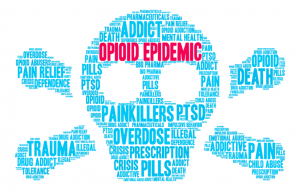(ThyBlackMan.com) The December 8th death of hip hop/emo rapper Jarad Higgins, known professionally as Juice WRLD following complications from a seizure from a not confirmed but apparent opioid overdose came as a surprise to those familiar with the up and coming artist. After his passing, his death made me question if the opioid crisis, thought to only affect white communities, had come to reach out its destructive tentacles to the Black community as a whole? After the deaths of fellow performers/musicians like Prince and Michael Jackson, it seemed to be a valid concern.
Juice WRLD’s had just turned 21years old six days before his untimely demise of what has been rumored to be an overdose on Percocet, according to unconfirmed sources. WRLD was most famous of his emo/alternative hip hop hit “Lucid Dreams,” from the album Goodbye & Good Riddance, which peaked at No. 2 on the Billboard Hot 100 in 2018, or from his collaboration with Travis Scott (Astroworld) on the Spiderman: Into the Spider-Verse soundtrack. Gen Z’s unofficial musical spokesperson mastered a radio-friendly kind of misery themed songs, with his singing, rap style. As a result, he was able to spawn a type of adjacent hybrid know as emo rap – inspired by a drug fueled lifestyle. WRLD’s music combined elements of macabre pop, punk, hip hop, and R&B, according to Jon Caramanica from The New York Times. It appears Juice Wrld appears may have been the victim of his own excess. The result of an autopsy are still pending.
The nexus of the opioid crisis began in the late 1990s when pharmaceutical companies falsely assured the US public as well as members of the medical community that opioid pain relief would not become addictive for its users. Therefore, medical professionals began to increasingly prescribing these medications. It soon became clear that opioids could become highly addictive. Incidents where mothers delivered newborns who experienced opioid withdrawal, as well as increased opioid related deaths led the U.S. Department of Health and Human Services to declare opioid addiction a public health emergency in 2017.
Orla Kennedy, a Community Catalyst policy analyst, states that “drug overdose deaths continue to increase in the US. From 1999 to 2017, more than 702,000 people died from drug overdoses.” Also in 2017 alone, more than 70,000 people died from drug overdose making it a leading cause of injury related death in the US, of those deaths 68 percent involved a prescription or illicit opioid. Outreach programs seem to address the crisis with optimistic headlines that appear to show a decline in opioid related deaths suggesting an overall decrease. However, at the same time, talks of its effect in and around Black communities has been nonexistent. This apparent lack of concern in general from society at large suggests that opioid related deaths are not just about their effects on white communities.
According to Kennedy, Black communities have been devastated by drug related deaths for decades and that, nationally, opioid related deaths has been increasing more quickly in Black populations more than white ones. From 2016 to 2017, “the morality rate among Black non-Hispanic individuals rose by 25 percent compared to the 11 percent increase among white, non-Hispanic individuals, also emphasizing the crisis is not limited to white populations.” Joseph P. Williams believes, for the past several years, American attention has been fixated on fighting opioid overdoes in largely white communities. However, little attentions and resources address the Black population. The disparities in attention and long term strategies have led to a tale of two opioid crisis: One that is white, a malady of medical and mental health and the other Black, criminal and largely ignored, even as statistics continue to reveal that Blacks are dying at a skyrocking rates due to opioid abuses.
A study by the International Journal of Collaborative Research on Internal Medicine & Public and Public Health states, “Drug overdose by race increased among Black in urban setting by 40 percent in 2016 in that year alone. Also, a 2018 study in the Journal of the American Medical Association report argues that because Blacks and other nonwhites are not likely to receive opioids for pain in an ER department, it is possible that pills would be sold on the streets to Black patients. Regardless, overall deaths keep climbing each year.
A US News and World Report analysis using CDC data found that the rate of fatal opioid related overdoses among Blacks averaged 3.7 deaths per 100,000 between 2005 and 2013, far below the 7.6 average rage for whites during the same time. Yet, between 2014 and 2017, the fatal overdose rate among Blacks rose by 130 percent, more than twice the 61.5 percent for whites over the same period. Moreover, the number of Black overdose victims in urban areas soared in recent years from roughly five deaths per 100,000 in 2012 to about 17 in 2017. The increase in opioid related deaths, according to Dr. Evan Long, a physician and the chief integrated health officer at Heartland Alliances says, it’s a “symptom of a much larger rote case,” specifically people and communities grappling with decades of unaddressed trauma. It comes as no surprise that for years, research indicating the unmet need of substance addiction treatment is worse for Blacks and Latinx communities compared to whites.
According to Dr. Elizabeth Salisbury-Afsar, Medicaid or private insurance may not always cover the full scope of often expensive inpatient treatment programs. Compound this and other hurdles, if a patient has a criminal record and/or struggle to find jobs and supportive families is another obstacle to recovery which can sometimes take several years. Salisbury-Afsar further explains that helping a patient get into a program, navigate insurance bureaucracies and commit can be tenuous because if patients who don’t have the opportunity to complete treatment often end up relapsing.
Race-based healthcare disparities are historic across all healthcare systems. As a result, this county need a more anti-racist approach healthcare to ensure improved outcomes overall.
The Chicago Urban League issued brief,
Sources:
Orla Kennedy. The Opioid Crisis in Black Communities: Who is Paying Attention?”. 20. Feb. 2019. Community Catalyst. Web. 10. Dec. 2019
Joseph P. Williams. “Separate, Unequal and Overlooked.” 28. Jan. 2019. US News and World Report. Web. 11. Dec. 2019
Jon Caramanica. “Juice WRLD and the Tragic End of the Soundcloud Rap Era.” 09. Dec. 2019. The New York Times. Web. 11. Dec. 2019
Staff Writer; Gustavus Betts
One may connect with this brother on Facebook; G. Betts and Twitter; Gustavusb.

















Leave a Reply